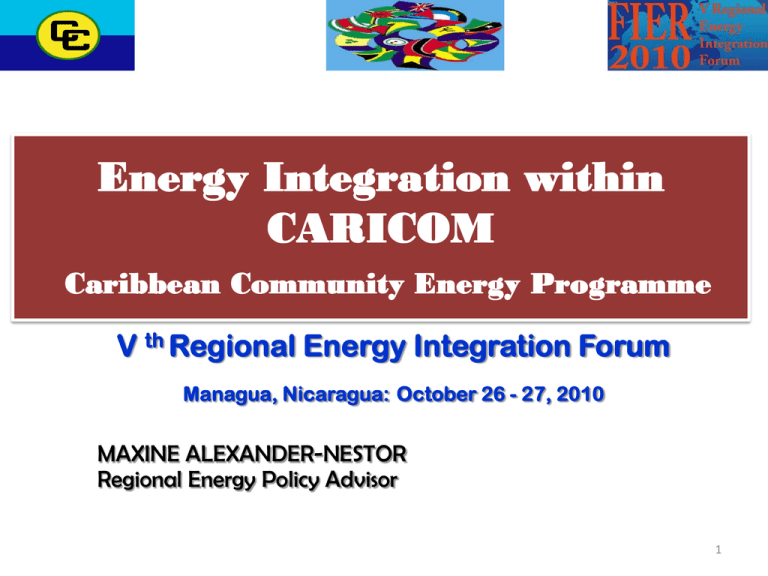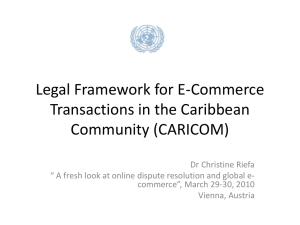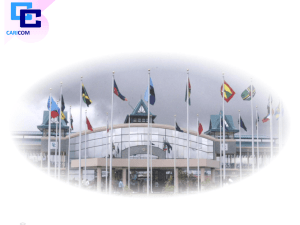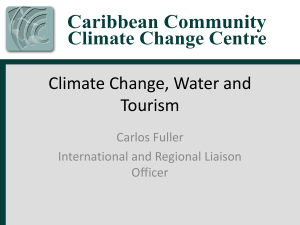benefits of energy integration
advertisement

Energy Integration within CARICOM Caribbean Community Energy Programme V th Regional Energy Integration Forum Managua, Nicaragua: October 26 - 27, 2010 MAXINE ALEXANDER-NESTOR Regional Energy Policy Advisor 1 STRUCTURE OF PRESENTATION ﻌ ﻌ ﻌ ﻌ ﻌ ﻌ BACKGROUND ENERGY SOURCES BENEFITS OF ENERGY INTEGRATION BARRIERS TO ENERGY INTEGRATION REGIONAL POLICIES AND STRATEGIES PROPOSED INTEGRATION INITIATIVES WITHIN CARICOM ﻌCONCLUSIONS 2 WHAT IS THE CARIBBEAN COMMUNITY? Intergovernmental Organization Common Market transformed into Caribbean Single Market and Economy CARICOM’s objectives inter alia are: Established by the Treaty of Chaguaramas Revised treaty signed in July 2001 Foster regional integration and collaboration Common Market established Promote enhanced trade and economic relations among Members Treaty signed on July 4th 1973 effective August 1, 1973 3 CARICOM MEMBER STATES Total land area – 465,000 km2 Total population – 16.7 million GDP / per capita ranges from: US$ 21,529 (Bahamas) – US $733 (Haiti)* Monsterrat? Type of economies: - Agricultural - Service oriented - Industrial * Source: IMF 2009 4 CARICOM ENERGY SITUATION Vast potential for renewable energy deployment Heavy reliance on fossil fuel for electricity generation and general energy use All CARICOM countries are Net importers of petroleum except Trinidad and Tobago Fuel accounts for about 40% of national budget Volatility of oil prices is a threat!!! 5 Continuation…… Constraints on fuel diversification on a standalone country basis: About 50% of utilities are state-owned. Archaic legislation – monopolies exists. Little scope for private producers. Some renewables not viable on a small scale. Small market size, low density consumption; Low purchasing power; Relatively low industrial demand. Energy demand expected to double over the next twenty years – annual growth rate 3.7% Source: World Bank Report 2010 6 ENERGY AND CLIMATE CHANGE CARICOM countries are carbon producers. Emissions levels relative small. Need to ‘get on board’ and contribute to the reduction of CO2 as part of the global programme to address the issue of climate change. Resources available to support sustainable energy development as part of the Climate Change agenda. Need to position Climate Change issues to access these resources: - to enhance mitigation; - facilitate development of low carbon development in Member States. 7 STRUCTURE OF PRESENTATION ﻌ ﻌ ﻌ ﻌ ﻌ ﻌ BACKGROUND ENERGY SOURCES BENEFITS OF ENERGY INTEGRATION BARRIERS TO ENERGY INTEGRATION REGIONAL POLICIES AND STRATEGIES PROPOSED INTEGRATION INITIATIVES WITHIN CARICOM ﻌCONCLUSIONS 8 MAJOR ENERGY RESOURCES IN CARICOM GAS AND PETROLEUM GEOTHERMAL WIND HYDROPOWER • Trinidad & Tobago – major producer. All domestic generation from gas. Supplies LNG to Puerto Rico and Dominican Republic. • Suriname and Belize produce limited amount of petroleum for domestic consumption. • Barbados produces crude oil and sends to Trinidad for refining. Small amount of gas produced. • Refinery in Jamaica. • Nevis geothermal resources estimated to be in range of 500+ MW. 10 MW development underway to supply islands of St. Kitts and Nevis. • Dominica geothermal project at preparatory stage. Supplies to Martinique and Guadeloupe anticipated. • St. Vincent and the Grenadines and Saint Lucia have potential. • 20 MW Wigton wind farm in Jamaica currently being expanded by 18 MW. • Guyana has 7000 MW potential, enough to supply the entire CARICOM. • In Belize Mollejon Hydropower adds 25.3 MW to the grid and Chalillo adds another 7.3 MW. • Kabalebo Hydroelectric Project in Suriname generates between 450 MW - 650 MW. • Péligre hydroelectric plant has installed capacity of 47.1 MW. • 2.2 MW wind farm commissioned d in Nevis in August. 9 TRINIDAD AND TOBAGO COUNTRY BRIEF Production almost doubles consumption In 2008, 165,420 barrels per day (bbl/d) of total oil produced (114,280 bbl/d crude oil, the remainder mostly consisting of natural gas liquids (NGLs)). An estimated 41,000 bbl/d of oil was consumed domestically, allowing it to export a sizable amount of its production. The largest oil producer in the country is the state-owned Petroleum Company of Trinidad and Tobago (Petrotrin). Other large producers include BP Trinidad and Tobago and BHP Billiton. 10 DIVERSIFICATION OF ENERGY SOURCES Energy security Proximity of Member States Greater efficiencies Lower long run marginal cost Minimise effects of climate change - GHG Reduce foreign oil expenditures – for oil imports Greater opportunities for energy trade Requires grid infrastructure Integrated energy policy framework required 11 STRUCTURE OF PRESENTATION ﻌ ﻌ ﻌ ﻌ ﻌ ﻌ BACKGROUND ENERGY SOURCES BENEFITS OF ENERGY INTEGRATION BARRIERS TO ENERGY INTEGRATION REGIONAL POLICIES AND STRATEGIES PROPOSED INTEGRATION INITIATIVES WITHIN CARICOM ﻌCONCLUSIONS 12 BENEFITS OF ENERGY INTEGRATION Lower energy prices and increased system reliability (i.e. the n-2 rule - generating plants in operation must at all times be able to carry the full load) – This requires significant spare capacity, creating burden on the small utilities and consumers as this translates to high electricity prices.). Security of energy supplies. Economies of scale. Strengthen regional cooperation integration and energy trade (Art. 15 (2) (f) – Revised Treaty). 13 Reduce cost of investments. Benefits cont’d …. Enhance economic feasibility of large-scale RE developments. Reduce consumption of fossil fuels and CO2 emissions. Enhance universal access to electricity in Member States which have unserved population. (Revised Treaty promotes regional harmonisation and energy integration). 14 Relevant provisions of Revised Treaty Article 52 (8): For the purpose of this Article, "production integration" includes:(a) the direct organisation of production in more than one Member State by a single economic enterprise; (Endorsement for the integration of Member States through transmission lines for distribution of electricity produced in one country?) Article 74: The COTED shall promote the modernisation of government bureaucracies by, inter alia:(b) removing impediments and improving the regulatory framework for economic enterprises at national and regional levels; (Backing for independent regulatory structure at the national and regional levels to enhance commercial 15 enterprises including electricity generation) STRUCTURE OF PRESENTATION ﻌ ﻌ ﻌ ﻌ BACKGROUND ENERGY SOURCES BENEFITS OF ENERGY INTEGRATION BARRIERS TO ENERGY INTEGRATION ﻌREGIONAL POLICIES AND STRATEGIES ﻌPROPOSED INTEGRATION INITIATIVES WITHIN CARICOM ﻌCONCLUSIONS 16 BARRIERS TO ENERGY INTEGRATION Non-existing inter-island / country transmission infrastructure. need for regional strategy on integrated electricity market. Lack of financing by utilities. requires commitment from policy-and decision makers, private and public sector, and multilateral organizations. Absence of legal and regulatory framework to promote integration. national sector laws to be revised to facilitate unbundling, cross border electricity supplies etc . significant regulatory oversight required to set rules and operational criteria. National and Regional regulatory regime to be improved. Absence of inter-Governmental and other inter-parties agreements. Governments in the region to develop bilateral Agreements for cross border transmission of electricity as contemplated by the Revised Treaty. Multiparty agreements amongst IPPs, utilities, gas suppliers etc Lack of technical and organizational capacity to develop commercial agreements. need for pooling of expertise and resources and sharing of information (technical information on systems requirement, load profile, generating cost etc.) Not all potential interconnection project may prove to be economically or environmentally viable. more detailed assessment and analysis needs to be conducted 17 STRUCTURE OF PRESENTATION ﻌ ﻌ ﻌ ﻌ ﻌ BACKGROUND ENERGY SOURCES BENEFITS OF ENERGY INTEGRATION BARRIERS TO ENERGY INTEGRATION REGIONAL POLICIES AND STRATEGIES ﻌPROPOSED INTEGRATION INITIATIVES WITHIN CARICOM ﻌCONCLUSIONS 18 CARICOM ENERGY POLICY Draft Policy developed by Task Force and submitted to Heads of Government in 2007. Genesis of policy relates to issue of national treatment. Study commenced in February 2010 – to be completed by November 2010. Study will assess the structure of energy pricing, including LNG within the context of CSME. Outputs to be fed into draft policy. Revised draft policy to be considered by Council of Technical and Economic Development (COTED). Pricing Study identified as being fundamental to the finalization of the Policy. Gap analysis to be conducted COTED to submit decision on revised draft policy to HOG. 19 CARICOM ENERGY POLICY Cont’d Universal access to sustainable and secure supplies of energy Diversification of energy sectors as a foundation for economic development Optimization of domestic production of energy in an environmentally sound manner Relationship between energy and international competitiveness of regional industries Four pillars which underpin the regional policy 20 CARIBBEAN SUSTAINABLE ENERGY ROAD MAP & STRATEGY Development of CSERMS approved by CARICOM HOG in 2009. 21 C-SERMS cont’d ….. C-SERMS will: define a strategic and targeted approach to increasing the contribution of renewable energy, energy efficiency and bio-energy in the energy mix. provide the basis for firm commitments by Government of the region, and development partners in achieving this objective. be a dynamic and living document to be refined and updated over time. set achievable short, medium and long-term targets (2015, 2020, 2025). The CARICOM Secretariat has received initial support from the IDB to commence development of C-SERMS-1. Additional funds to be 22 mobilized for remaining phases. STRUCTURE OF PRESENTATION ﻌ ﻌ ﻌ ﻌ ﻌ ﻌ BACKGROUND ENERGY SOURCES BENEFITS OF ENERGY INTEGRATION BARRIERS TO ENERGY INTEGRATION REGIONAL POLICIES AND STRATEGIES PROPOSED INTEGRATION INITIATIVES WITHIN CARICOM ﻌCONCLUSIONS 23 PROPOSED INTEGRATION INITIATIVES WITHIN CARICOM Adopted from the 2010 Study conducted by the World Bank titled: “Caribbean Regional Electricity Generation, Interconnection, and Fuels Supply Strategy”. Gas Market Eastern Caribbean Gas Pipeline: • Tobago, Barbados, Martinique, St. Lucia, Guadeloupe • 1,000 km • Pipeline gas half as costly as distillates • Highly economic Source: Franz Gerner – World Bank 24 Regional Initiatives cont’d Electricity Market I Dominica Interconnections Geothermal • Dominica-Martinique -100 MW, -70 km, -US$588/kW -Highly economic • Dominica-Guadeloupe -100 MW, -70 km, -US$588/kW -Highly economic Source: Franz Gerner – World Bank 25 Electricity Market II Regional Initiatives cont’d Nevis - St. Kitts/Nevis-US VI/NevisPuerto Rico Source: Franz Gerner – World Bank Nevis – Puerto Rico - Geothermal - 400 MW, - 400 km, - US$ 1,790/kW -Highly economic Nevis – St. Kitts - Geothermal - 50 MW, - 5 km, - US$328/kW -Highly economic Nevis – US Virgin Islands - Geothermal - 80 MW, - 320 km, - US$ 3,540/kW - Marginally economic 26 Regional Initiatives cont’d Electricity Market II Dominican Republic – Haiti Land Connection Source: Franz Gerner – World Bank • HFO steam plant 250 MW, • 560 km, US$1,900/kW • Uneconomic unless from lower cost energy source 27 Regional Initiatives cont’d Electricity Market IV Northern Caribbean Interconnection Interconnection linking Florida-Cuba-Haiti-Dominican Republic-Puerto Rico-Nevis 28 Regional Initiatives cont’d Electricity Market V Guyana Hydro Interconnection/ Suriname - Guyana Other initiatives not considered under the World Bank Study: Hydroelectric power from Guyana to: - Brazil (state of Roraima) - Trinidad US Virgin Islands Puerto Rico Dominican Republic Hydropower or hydrocarbon trade between Guyana and Suriname. Source: ENMAN Services – Trinidad & Tobago 29 Regional Initiatives cont’d BELIZE ELECTRICITY MARKET REPRESENTS A CLASSIC CASE OF ELECTRICITY INTEGRATION AND MARKET COMPETITION IN ELECTRICITY GENERATION. EXISTING INTERCONNECTION OF SYSTEMS BETWEEN BELIZE AND MEXICO. Peak Load –74 MW Customers – 74,000 Power Supply: - Hydro IPP’s – 36 MW – Mexico ‐ 50 MW – Company owned Diesel Fired 32 MW Source: Lynn Young – Belize Electricity Limited 30 STRUCTURE OF PRESENTATION ﻌ ﻌ ﻌ ﻌ ﻌ ﻌ BACKGROUND ENERGY SOURCES BENEFITS OF ENERGY INTEGRATION BARRIERS TO ENERGY INTEGRATION REGIONAL POLICIES AND STRATEGIES PROPOSED INTEGRATION INITIATIVES WITHIN CARICOM ﻌCONCLUSIONS 31 CONCLUSIONS Notwithstanding the fact that all of the CARICOM Member States are endowed with renewable energy resources, electricity generation by fossil fuel is dominant. This poses a threat to environmental and economic security of the region. Many of the RE projects require large ‘take-up’ to make them economically feasible. Transmission of electricity within the region and within some Member States is currently fragmented. As a result inefficiencies exist. 32 CONCLUSIONS Integrated electricity system is fundamental to the sustainability of the region’s energy sector. Preliminary assessments of potential integrated systems need to be complemented with detailed studies. Innovative financing mechanisms should be leveraged as far as possible to make schemes viable. Political will for integrated systems need to be bolstered and commitment required from private and public organization, including utilities, investors, financiers, developers, gas producers etc. 33 CONCLUSIONS Strategies, policies and regulatory framework are required at regional level to support energy integration in CARICOM and give effect to the Revised Treaty. There are opportunities for greater collaboration between OLADE and CARICOM on the issue of energy integration: – Lessons to be learnt from success stories and experiences in electricity interconnections in Latin America; – Technical experts to support detailed studies on various integration models; – Support in designing legal and regulatory framework for energy interconnection and negotiating commercial 34 agreements. Contact: Joseph Williams Manager, Energy Programme Caribbean Community Secretariat Tele: 592 -222-0001-75 Ext 3521 592-222-0139 (Direct) Fax :592-222-0155 E-mail: jwilliams@caricom.org; jwilliams6764@gmail.com SKYPE 'jwilliams67641“ __________________________ Maxine Alexander Nestor Regional Energy Policy Advisor Caribbean Renewable Energy Development Project c/o Caribbean Community Secretariat Tele: 592-222-0001-75 Ext. 3501 592-222-0222 (direct) email: mnestor@caricom.org skype: maxine.alexander.nestor 35











